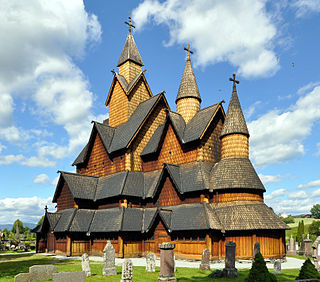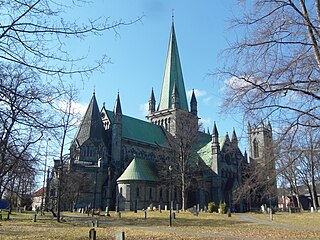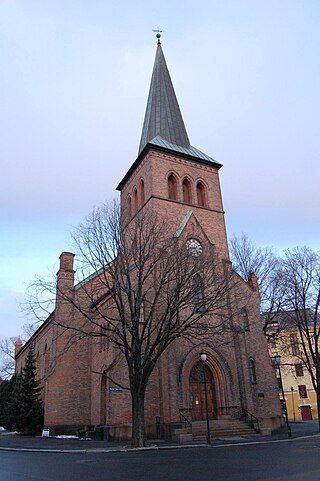
A stave church is a medieval wooden Christian church building once common in north-western Europe. The name derives from the building's structure of post and lintel construction, a type of timber framing where the load-bearing ore-pine posts are called stafr in Old Norse. Two related church building types also named for their structural elements, the post church and palisade church, are often called 'stave churches'.

The Tune ship (Tuneskipet) is a Viking ship exhibited in the Viking Ship Museum in Bygdøy, Oslo.

Hallvard Vebjørnsson, commonly referred to as Saint Hallvard, is the patron saint of Oslo. He is considered a martyr because of his defence of an innocent thrall woman. His religious feast day is 15 May.

The Old Bishop's Palace in Oslo was the residence of the Roman Catholic bishops of Oslo. The estate is located in what is now called Gamlebyen in Oslo, Norway. Various remnants of the medieval bishop's original palace are still visible.

Hovedøya Abbey was a medieval era Cistercian monastery on the island of Hovedøya in Oslofjord outside of Oslo, Norway.

St. Mary's Church was a medieval church located in Oslo, Norway. The church ruins are located in Middelalderparken near the neighborhood of Sørenga in the borough of Gamlebyen.
St. Olav’s Shrine was the resting place of the earthly remains of St. Olav, Norway’s patron saint, behind the high altar of Nidaros Cathedral in Trondheim, Norway, from the mid 11th century. For nearly five centuries the shrine was of major religious importance to Norway and the other Nordic countries, and also to other parts of Northern Europe. St. Olav’s Shrine opens and closes the Middle Ages as a historic period in Norway. The shrine consisted of three shrines, the one covering the other, and was the most important and by far the most valuable object in Norway in the Middle Ages. After the Lutheran reformation in 1536–1537, the valuable parts of St. Olav’s Shrine were destroyed by Danish authorities. Since 1568 St. Olav’s earthly remains have been resting in an unknown grave, in Nidaros Cathedral or in the cathedral cemetery.

St. Hallvard's Cathedral (Hallvardskatedralen) was the former Oslo Cathedral. It fell into disrepair in the 17th century and is today in ruins. The site is located between Bispegata and St. Halvards gate in Oslo, Norway.

St. Margaret's Church was a medieval stone church located on the outskirts of Oslo, Norway.

The Medieval Park is located in the borough of Gamle Oslo in Oslo, Norway. The park was opened in the year 2000 at Sørenga in what was once the southern part of the medieval city of Oslo. The park is located within an area which also included the Minneparken and Ladegården on the north side of Bispegata. Development in the area is prohibited due to ruins and cultural layers above and below ground.

The Old Town of Oslo is a neighbourhood in the inner city of Oslo, Norway, belonging to the borough of Gamle Oslo and is the oldest urban area within the current capital. This part of the capital of Norway was simply called Oslo until 1925 while the city as a whole was called Kristiania. Oslo's old town was established with the urban structure around the year 1000 and was the capital of Norway's dominion in 1314. The main Old Town area has several ruins of stone and brick lying above ground, and large amounts of protected culture underground. The core area also has listed 1700s buildings. Towards Ekeberg slope and further up are some 17th and 18th-century wooden houses that are zoned for conservation under the Planning and Building Act, though there exist in the Old Town many four-storey brick houses, built at the end of the 1800s, and some heritage railway buildings from different eras.

Erling Viksjø was a Norwegian architect. Viksjø was an early exponent of architectural modernism. He was also noted for his use of textured concrete as a building material in a number of his designs.

Church building in Norway began when Christianity was established there around the year 1000. The first buildings may have been post churches erected in the 10th or 11th century, but the evidence is inconclusive. For instance under Urnes Stave Church and Lom Stave Church there are traces of older post churches. Post churches were later replaced by the more durable stave churches. About 1,300 churches were built during the 12th and 13th centuries in what was Norway's first building boom. A total of about 3,000 churches have been built in Norway, although nearly half of them have perished. From 1620 systematic records and accounts were kept although sources prior to 1620 are fragmented. Evidence about early and medieval churches is partly archaeological. The "long church" is the most common type of church in Norway. There are about 1620 buildings recognized as churches affiliated with the Church of Norway. In addition, there are a number of gospel halls belonging to the lay movement affiliated with the Church of Norway as well as churches belonging to other Christian bodies. Until the 20th century, most churches were built from wood. 220 buildings are protected by law, and an additional 765 are listed as valuable cultural heritage.

The Holy Cross Church was a small medieval parish church for the northern part of the Old Town of Oslo, Norway. The ruin was rediscovered in 1922 and is now a part of Minneparken containing the ruins of the church and the larger St. Hallvard's Cathedral.

Minneparken is situated in Gamle Oslo adjacent to Oslo torg at Gamlebyen in Oslo, Norway. The park is bounded by St. Hallvards plass and Oslo gate in the west, Bispegata in the south, St. Halvards gate in the southeast, Egedes gate in the east and Arups gate in the north.
The following is a timeline of the history of the city of Oslo, Norway.

Kampen Church is a church in the neighborhood of Kampen in Oslo, Norway. The church was consecrated 29 November 1882. After a fire in Kampen in 1878, the plans for the reconstruction of the neighborhood included a new church. In 1880, the neighborhood was founded a new congregation, that was located elsewhere until the church was finished.

The Avaldsnes Kongsgård estate was a king's estate (Kongsgård) which is believed to be the oldest royal residence and seat of power in Norwegian history. The estate was located in the present day village of Avaldsnes in the county of Rogaland.

The Fåberg stone is a runestone next to Fåberg Church in the village of Fåberg in the municipality of Lillehammer in Innlandet County, Norway. It is registered with the Norwegian Directorate for Cultural Heritage under number 58558.

Hurum Church is a medieval stone church in Hurum, Norway. It was constructed in the 12th century. The church was damaged by fire in 1686, and rebuilt with a baroque interior. Next to the church, the Huitfeldt-family built a wooden funeral chapel in the second half of the 17th century. A new stone chapel was built in 1750, and contains the remains of the naval commander Iver Huitfeldt.


















